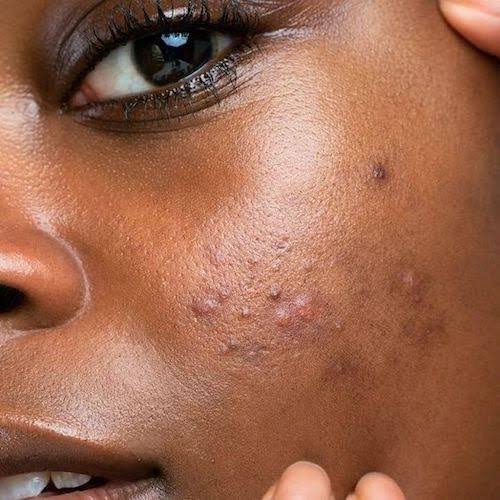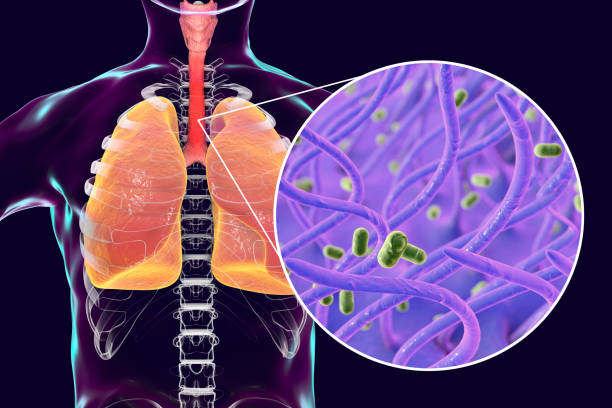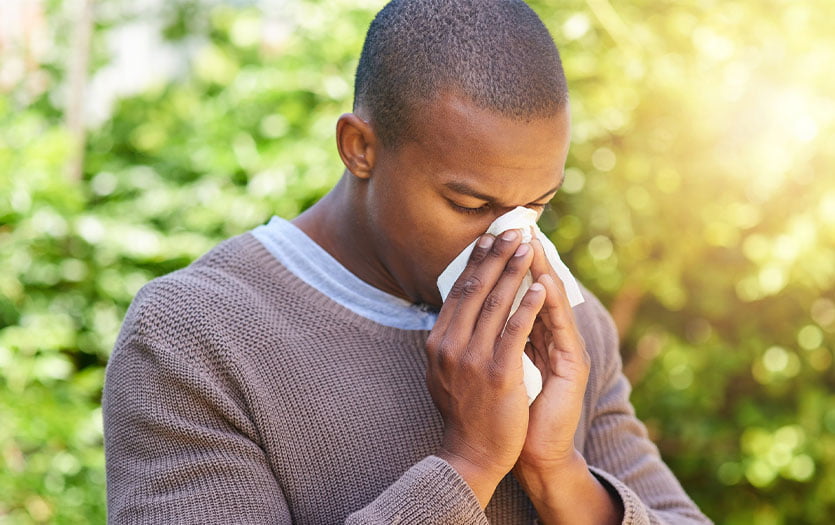An “allergic reaction” is the way your body responds to the allergen. A chain of events occur that result in an allergic reaction.
If you are prone to allergies, the first time you’re exposed to a specific allergen (such as pollen), your body responds by producing allergic (IgE) antibodies. The job of these antibodies is to find the allergens and help remove them from your system. As a result, a chemical called histamine is released and causes symptoms of allergies.
You can be allergic to a wide variety of substances – including pollen, animal dander, mold and dust mites.
Pollen
Seasonal allergic rhinitis, or hay fever, is an allergic response to pollen. It causes inflammation and swelling of the lining of your nose and of the protective tissue of your eyes (conjunctiva).
Symptoms include sneezing, congestion (feeling stuffy), and itchy, watery eyes, nose and mouth. Treatment options include over-the-counter and prescription oral antihistamines, anti-leukotrienes, nasal steroids, nasal antihistamines, and nasal cromolyn. In some people, allergic asthma symptoms (wheezing, shortness of breath, coughing, and/ or chest tightness) can be caused by exposure to pollen.
Your symptoms can be reduced by avoiding pollen. Stay indoors when pollen counts are high, close your windows, and use air conditioning. Ask your healthcare provider about immunotherapy (“allergy shots”) to treat pollen allergy.
Dust mites
Dust mites are tiny organisms that live in dust and in the fibers of household objects, such as pillows, mattresses, carpet, and upholstery. Dust mites grow in warm, humid areas.
The symptoms of dust mite allergy are similar to those of pollen allergy. To help manage dust mite allergies, try using dust mite encasements (airtight plastic/polyurethane covers) over pillows, mattresses, and box springs. Also, remove carpet, or vacuum frequently with a high-efficiency filter vacuum cleaner. Treatment may include medications to control your nasal/eye and chest symptoms. Immunotherapy may be recommended if your symptoms are not adequately controlled with avoidance methods and medications.
Molds
Molds are tiny fungi (like Penicillium) with spores that float in the air like pollen. Mold is a common trigger for allergies. Mold can be found indoors in damp areas, such as the basement, kitchen, or bathroom, as well as outdoors in grass, leaf piles, hay, mulch or under mushrooms. Mold spores reach a peak during hot, humid weather.
Treatment may include medications to control your nasal/eye and chest symptoms. Immunotherapy may be recommended if your symptoms are not adequately controlled with avoidance and medications.
Animal dander
Allergic reactions can be caused by the proteins secreted by sweat glands in an animal’s skin, which are shed in dander, and by the proteins in an animal’s saliva. Avoidance measures don’t work as well as simply removing the pet from your home. However, because many people are reluctant to do this, second-best measures include keeping your pet out of your bedroom, using air cleaners with HEPA filtration and washing your pet (cat or dog) frequently.
Treatment may include medications to control your nasal/eye and chest symptoms. Immunotherapy may be recommended if your symptoms are not adequately controlled with avoidance methods and medications.
Latex
Some people develop a latex allergy after repeated contact with latex. Rubber gloves, such as those used in surgery or home cleaning, are a major source for causing this type of reaction. Skin rash, hives, eye tearing and irritation, wheezing and itching of the skin may occur if you have a latex allergy.
Allergic reactions to latex can be mild, such as skin redness and itching. More severe reactions can occur if your mucosal membranes are exposed, such as during an operation or a dental or gynecologic exam.
Treatment of latex reactions begins by removing the offending latex product. If you have latex allergy, it is important for you to wear a Medic Alert® bracelet and carry an emergency epinephrine kit. All procedures should be carried out in a “latex-safe” fashion. There is no cure for latex allergy, so the best treatment for this condition is prevention and avoidance.
Certain foods
Food allergies develop when your body develops a specific antibody to a specific food. An allergic reaction occurs within minutes of eating the food, and symptoms can be severe. In adults, the most common food allergies are shellfish, peanuts and tree nuts. In children, they include milk, egg, soy, wheat, shellfish, peanuts and tree nuts.
If you have a food allergy, your symptoms include itching, hives, nausea, vomiting, diarrhea, breathing difficulties and swelling around your mouth.
It is extremely important to avoid the foods that cause allergy symptoms. If you (or your child) have a food allergy, your doctor may prescribe injectable epinephrine (adrenaline) for you to carry at all times. This is needed in case you accidentally eat foods that cause allergies. There are new therapies for peanut allergies called oral immunotherapy.
Insect venom (stings)
If you get a bee sting, a normal symptom includes pain, swelling and redness around the sting site. A large, local reaction includes swelling that extends beyond the sting site. For example, if you are stung on the ankle, you may see swelling in your leg.
The most serious reaction to an insect sting is an allergic one, which needs immediate medical attention. Symptoms of an allergic reaction to an insect sting include:
– Difficulty breathing.
– Generalized (widespread) hives that appear as a red, itchy rash that spreads to areas other than the area that was stung.
– Swelling of your face, throat or mouth tissue.
– Wheezing or difficulty swallowing.
– Restlessness and anxiety.
– Rapid pulse.
– Dizziness or a sharp drop in your blood pressure.
If you have a reaction like this, a re-sting can cause a serious reaction that can be life-threatening.
An allergic reaction is treated with epinephrine (adrenaline). If you’ve had an allergic reaction to bee stings, see a board-certified allergy/immunologist to get a skin and/or blood test to confirm your allergy to bee venom. Venom immunotherapy is recommended if venom allergy is confirmed. This will help reduce the possibility that a re-sting will cause a serious reaction.
Symptoms of allergy
Allergy symptoms are classified as mild, moderate or severe:
Mild reactions include local symptoms (affecting a specific area of your body) such as a rash or hives, itchiness, watery/red eyes, hay fever and runny nose. Mild reactions do not spread to other parts of your body.
Moderate reactions include symptoms that spread to other parts of your body. Symptoms may include itchiness, hives, and/or swelling and trouble breathing.
A severe allergic reaction, known as anaphylaxis, is a rare, life-threatening emergency in which your body’s response to the allergen is sudden and affects the whole body. Anaphylaxis may begin with severe itching of your eyes or face. Within minutes, more serious symptoms appear, including throat swelling (which could cause problems with swallowing and breathing), abdominal pain, cramps, vomiting, diarrhea, hives and swelling (angioedema). You may also have mental confusion or dizziness, since anaphylaxis may cause a drop in blood pressure.
Natural ways of treating Allergies
Honey
Although there’s no scientific evidence to prove it, a popular theory suggests eating locally produced honey. According to the theory, you will lower your allergic reaction over time to the pollen that the bees collect in your area to make their honey.
Vitamin C
Practitioners of natural medication suggest taking 2,000 milligrams of vitamin C daily to reduce histamine levels.
Peppermint essential oil
A 1998 study showed that peppermint oil treatment had enough anti-inflammatory effects that reduced the symptoms of bronchial asthma and allergic rhinitis to warrant clinical trials. Essential oils can be diffused into the air but should be diluted in a carrier oil if applied topically.
Eucalyptus essential oil
Advocates of natural healing suggest using eucalyptus oil as an antimicrobial agent by adding it to each load of wash during allergy season.
Frankincense essential oil
Based on the results of a 2016 study, frankincense oil may help against perennial allergic rhinitis. You can dilute it in a carrier oil and use behind your ears or use inhalation by diffusing it into the air.










